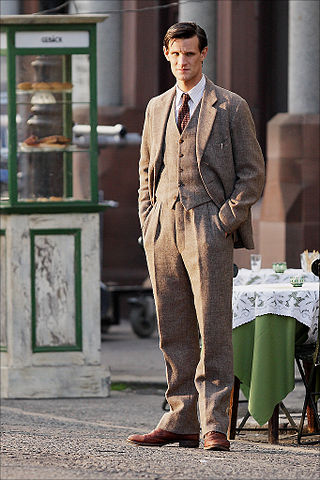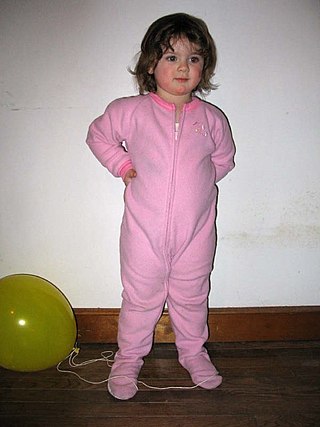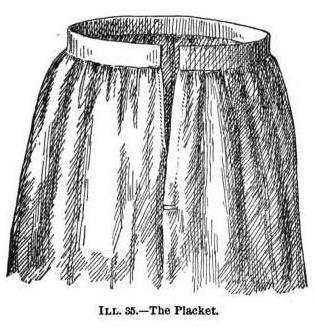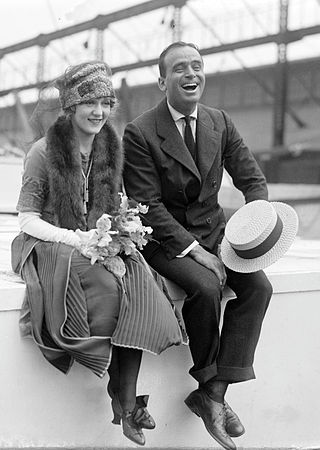
A loincloth or breechcloth is a one-piece male garment, sometimes kept in place by a belt, knots, laces, safety pins, velcro straps, buttons, snaps, buckles, zippers or hook-and-eye closures and worn as outer clothing or in the external environment. Typical components include front and back pockets, a little change pocket, belt loops and an elastic waistband. It covers the genitals and, at least partially, sometimes the buttocks, the area covered by the loincloth. Historically, the loincloth can be worn dependent upon the weather, wearer, and setting. Often, they are wrapped around the bottom and between the legs.

A sweater or pullover, also called a jersey or jumper, is a piece of clothing, typically with long sleeves, made of knitted or crocheted material that covers the upper part of the body. When sleeveless, the garment is often called a slipover, tank top, or sweater vest.

A shirt is a cloth garment for the upper body.

A zipper, zip, fly, or zip fastener, formerly known as a clasp locker, is a commonly used device for binding together two edges of fabric or other flexible material. Used in clothing, luggage and other bags, camping gear, and many other items, zippers come in a wide range of sizes, shapes, and colors. In 1892, Whitcomb L. Judson, an American inventor from Chicago, patented the original design from which the modern device evolved.

A suit, lounge suit, or business suit is a set of clothes comprising a suit jacket and trousers of identical textiles generally worn with a collared dress shirt, necktie, and dress shoes. A skirt suit is similar, but with a matching skirt instead of trousers. It is currently considered semi-formal wear or business wear in contemporary Western dress codes, however when the suit was originally developed it was considered an informal or more casual option compared to the prevailing clothing standards of aristocrats and businessmen. The lounge suit originated in 19th-century Britain as sportswear and British country clothing, which is why it was seen as more casual than citywear at that time, with the roots of the suit coming from early modern Western Europe formal court or military clothes. After replacing the black frock coat in the early 20th century as regular daywear, a sober one-coloured suit became known as a lounge suit.

A blouse is a loose-fitting upper garment that may be worn by workmen, peasants, artists, women, and children. It is typically gathered at the waist or hips so that it hangs loosely ("blouses") over the wearer's body. Today, the word most commonly refers to a girl's or woman's dress shirt, although there is considerable confusion between a true blouse and a women's shirt. It can also refer to a man's shirt if it is a loose-fitting style, though it rarely is. Traditionally, the term has been used to refer to a shirt which blouses out or has an unmistakably feminine appearance, although even many "standard" shirts today have a somewhat blousy fit, and the numbers of men wearing such shirts may match that of women wearing actual blouses.

The blanket sleeper is a type of especially warm sleeper or footie pajama worn primarily during the winter in the United States and Canada. The garment is worn especially by young children.

A frog is a type of ornamental braiding closure made out of cord, consisting of a button and a loop; it is used to fasten garments without creating an overlap. Its purpose is to act as a fastener as well as providing a decorative closure for the garment. It is especially used on the cheongsam, where the frog represents the cultural essence of the dress.
Clothing terminology comprises the names of individual garments and classes of garments, as well as the specialized vocabularies of the trades that have designed, manufactured, marketed and sold clothing over hundreds of years.
Adaptive clothing is clothing designed around the needs and abilities of people with varying degrees of disability, including congenital disabilities, acquired disabilities, age and temporary disabilities, as well as physical disabilities. Adaptive clothing is influenced by factors such as age, disability type, level of independence, mobility and dexterity, as well as whether a person requires help when dressing, such as from a caregiver. People who struggle with zippers, shoelaces, buttons or even fabrics and texture due to a type of disability may need adaptive clothing. Most adaptive clothing designs are taken from general-market clothing, the comfort of which began to increase in the 1950s, with new technologies such as elastic waistbands and stretchy fabrics.

A dress shirt, button shirt, button-front, button-front shirt, or button-up shirt is a garment with a collar and a full-length opening at the front, which is fastened using buttons or shirt studs. A button-down or button-down shirt is a dress shirt with a button-down collar – a collar having the ends fastened to the shirt with buttons.

A placket is a finished opening in the upper part of trousers or skirts, or at the neck, front, or sleeve of a garment. The finish frequently consists of a fold of fabric that is attached to the opening in order for the fasteners to be sewn to it. In modern usage, the term placket often refers to these double layers of fabric.

Western fashion in the 1920s underwent a modernization. For women, fashion had continued to change away from the extravagant and restrictive styles of the Victorian and Edwardian periods, and towards looser clothing which revealed more of the arms and legs, that had begun at least a decade prior with the rising of hemlines to the ankle and the movement from the S-bend corset to the columnar silhouette of the 1910s. Men also began to wear less formal daily attire and athletic clothing or 'Sportswear' became a part of mainstream fashion for the first time.

A sundress or summer dress is an informal or casual dress intended to be worn in warm weather, typically in a lightweight fabric, most commonly cotton, and usually loose-fitting. It is commonly a bodice style sleeveless dress, typically with a wide neckline and thin shoulder straps, and may be backless. A sundress is typically worn without a layering top and is not usually worn over a blouse, sweater, or t-shirt, or with leggings.
A cheerleading uniform is a standardized outfit worn by cheerleaders during games and other events. These uniforms typically include the official colors and mascots of the school or team and are designed to make the wearer appear physically attractive.

Locking clothing are garments which prevent the person wearing the clothing from removing the clothing. One example would be clothing designed to prevent a person with dementia from inappropriate undressing. Sometimes locking clothes are used for sexual purposes, such as in feminization.

A hook-and-eye closure is a simple and secure method of fastening garments together. It consists of a metal hook, commonly wire bent to shape, and an eye of the same material into which the hook fits.

Maternity clothing is worn by women as an adaptation to changes in body size during pregnancy. The evolution of maternity clothing began during the Middle Ages, and became fashionable as women became more selective about style and comfort in the types of maternity clothing they wore. Fashions were constantly changing over time, such as the high-waisted Empire silhouette style maternity dress that was fashionable at the turn of the 19th century, and the "wrapper" style dress of the Victorian era that a woman could simply wrap around herself and button up.

Underwear, underclothing, or undergarments are items of clothing worn beneath outer clothes, usually in direct contact with the skin, although they may comprise more than a single layer. They serve to keep outer clothing from being soiled or damaged by bodily excretions, to lessen the friction of outerwear against the skin, to shape the body, and to provide concealment or support for parts of it. In cold weather, long underwear is sometimes worn to provide additional warmth. Special types of undergarments have religious significance. Some items of clothing are designed as undergarments, while others, such as T-shirts and certain types of shorts, are appropriate both as underwear and outerwear. If made of suitable material or textile, some underwear can serve as nightwear or swimwear, and some undergarments are intended for sexual attraction or visual appeal.

Vera Borea is a French fashion house founded in 1931 in Paris, France, by Countess Borea de Buzzaccarini Regoli.



















